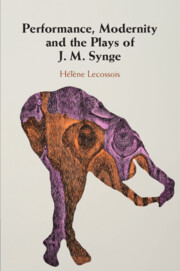Book contents
- Performance, Modernity and the Plays of J. M. Synge
- Performance, Modernity and the Plays of J. M. Synge
- Copyright page
- Epigraph
- Contents
- Figures
- Acknowledgements
- Abbreviations
- Introduction
- Chapter 1 Staging Authenticity
- Chapter 2 The Spectacle of Modernity
- Chapter 3 Performing the Repertoire
- Chapter 4 ‘Queer Bodies’
- Chapter 5 Unresolved Temporalities
- Chapter 6 Creative Failures
- Conclusion
- Bibliography
- Index
Chapter 1 - Staging Authenticity
Synge and Cultural Ethnography
Published online by Cambridge University Press: 09 November 2020
- Performance, Modernity and the Plays of J. M. Synge
- Performance, Modernity and the Plays of J. M. Synge
- Copyright page
- Epigraph
- Contents
- Figures
- Acknowledgements
- Abbreviations
- Introduction
- Chapter 1 Staging Authenticity
- Chapter 2 The Spectacle of Modernity
- Chapter 3 Performing the Repertoire
- Chapter 4 ‘Queer Bodies’
- Chapter 5 Unresolved Temporalities
- Chapter 6 Creative Failures
- Conclusion
- Bibliography
- Index
Summary
Chapter 1 is concerned with the ethnographical leanings of Synge’s work. It focuses on the material culture which Synge chose for the production of his plays, Riders to the Sea especially, and highlights the degree to which Synge’s plays were aligned with a narrative of modernity and progress. It effectively reads Synge’s plays as cultural performances of modernity. By transposing to the Dublin stage objects conjuring rurality and by giving centre-stage to a commodity-poor culture, the plays contributed to generating and articulating a fundamental difference between the modern, urban audience of the Abbey Theatre and the agrarian or fishing communities, which the plays represented. Thus, they participated in the construction and display of cultural difference, which is so central to modernity’s agenda. The chapter pays special attention to Synge’s quest for, or recreation of, the authentic, and argues that this should be situated within the broader context of the commodity culture emerging in late nineteenth and early twentieth-century Ireland. It also relates Synge’s work for the theatre to other art practices ‒ notably, photography and more specifically Jane W. Shackleton’s ‒ that were similarly informed by an equally strong ethnographical desire to document the lives of putatively primitive people.
Keywords
- Type
- Chapter
- Information
- Performance, Modernity and the Plays of J. M. Synge , pp. 22 - 55Publisher: Cambridge University PressPrint publication year: 2020



